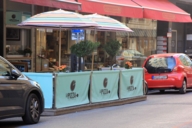
In Vienna, the Schanigärten, small open-air terraces in front of coffee houses, have a long tradition. In Munich, too, they have become indispensable.
The word “Schanigarten” also originated in the Austrian capital, where the most junior waiter or trainee was often referred to as “Jean”, which was eventually adapted to “Schani”. Carrying tables outside and setting them up would be Schanis' job during spring and summer, and so the name came to be associated with these outdoor hospitality spaces. And the Viennese phrase, “Schani, trag’ den Garten aussi” – Schani, carry the garden outside – is evidently being taken very literally in Munich.
The city’s restaurants, bars and cafés started working on their Schanigardens early this year, applying plenty of enthusiasm and creativity to make them particularly beautiful. In every corner of the city there were people hammering, sawing and drilling away. Trolley-loads of plants were carefully arranged in baskets, pots and tubs; many of the spaces feature kitchen herbs such as basil, rosemary and sage growing luxuriantly amid fragrant flowers, and some of these mini gardens even contain olive trees.
The railings, fences and surfaces of the little garden terraces are just as inspiringly painted, decorated and adorned, and all of them are of course illuminated after dark. Everyone helps everyone else, but there’s still a bit of competition: which establishment has the most beautiful Schanigarden?
Schani, trag’ den Garten aussi” – Schani, carry the garden outside – is evidently being taken very literally in Munich.
The most avid Schanigarden-builders in Munich appear to be the restaurateurs of Maxvorstadt and Schwabing: Türkenstrasse and Amalienstrasse are lined with Schanigarden upon Schanigarden. The diversity on show is impressive, and it seems like more appear every week.
You will also stumble across many of these open-air mini-oases if you take a walk or cycle around Altstadt, Glockenbachviertel, Haidhausen or Munich’s other city districts.
To truly qualify as a Munich "Schanigarten", the terrace must be on a space formerly used for parking. That means fewer parking spaces of course, but most car owners welcome these cosy new additions.
Incidentally, architect Alexander Fthenakis has written a whole book on the subject, entitled “Schanitown”, and he recently spoke about his fascination with Schanigardens in our interview with him.
In culinary terms too, the gardens cater to all tastes, every time of day, and every mood. Although some restaurants only open their outdoor areas later in the morning, you can always find some little corner where it’s possible to grab a breakfast coffee and a croissant.
Things get livelier around lunchtime, when the Schanigardens are flocked with diners – solo and in groups, tourists and locals alike. In the shade of colourful parasols they find themselves spoilt for choice, with Mediterranean delights and Asian delicacies on offer, light Bavarian cuisine, something vegetarian, or a fish poké bowl plus a nice cool drink on the side – truly a lunch par excellence.
The crowds really descend in the evening, but even then, with a little patience you should be able to find somewhere to enjoy a spritzer, a Hugo or a Moscow Mule if you walk around the neighbourhood a little.
The City of Munich authorities have decided that the Schanigardens should be a permanent fixture, so the outdoor bar and restaurant areas will now be permitted to supplant a few parked cars from April to October every year; a beautiful prospect for the people of Munich and a real attraction for visitors from all over the world!